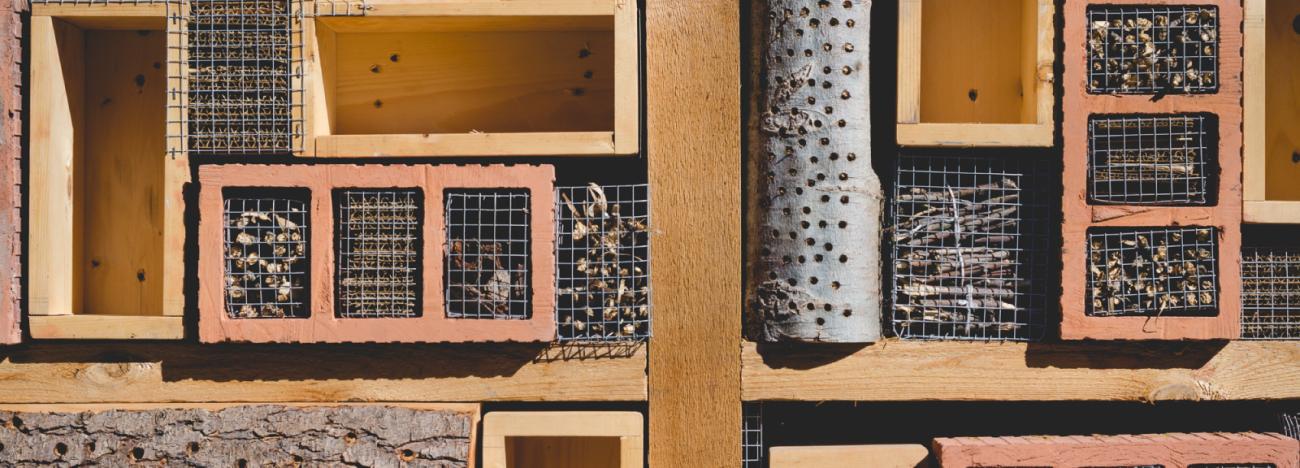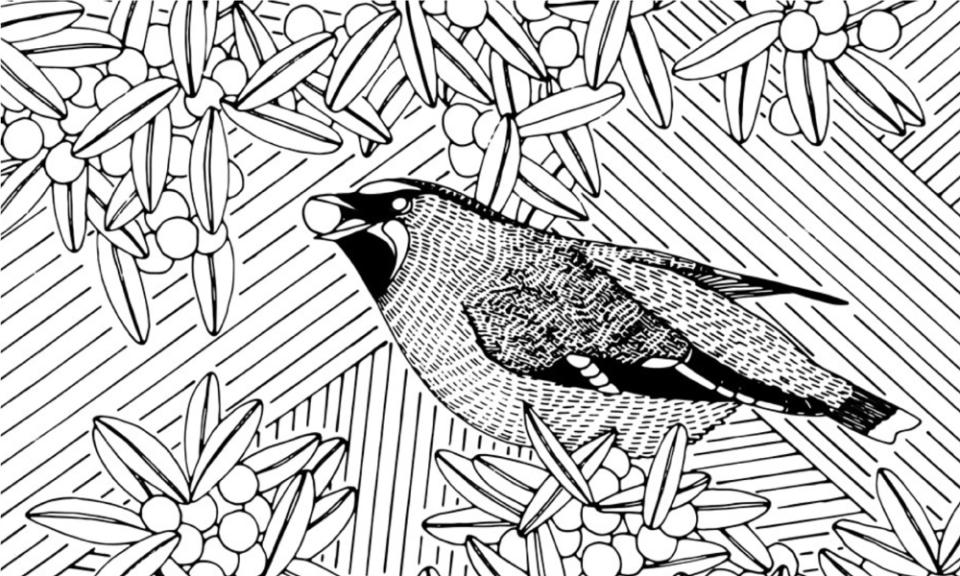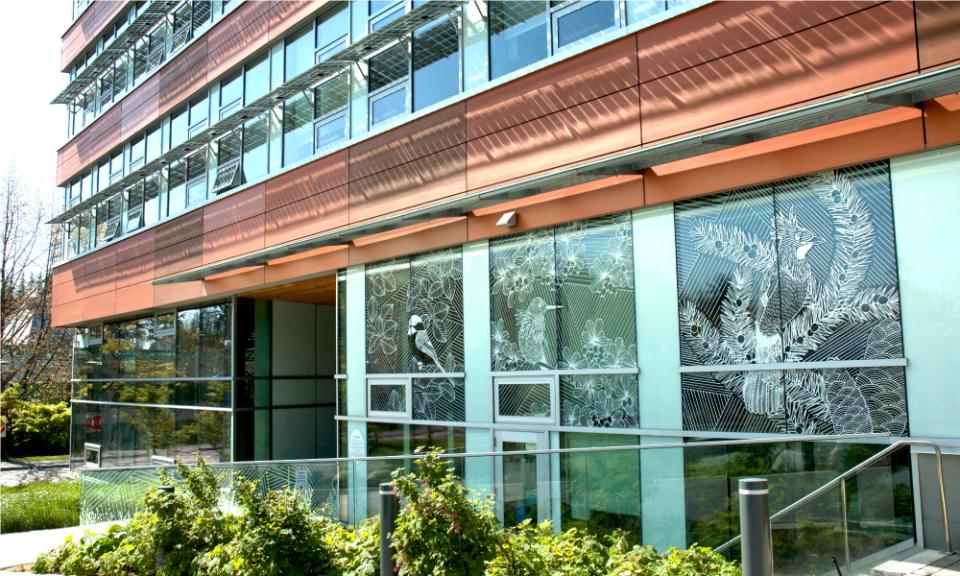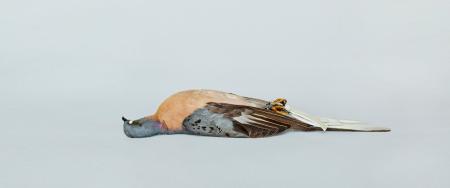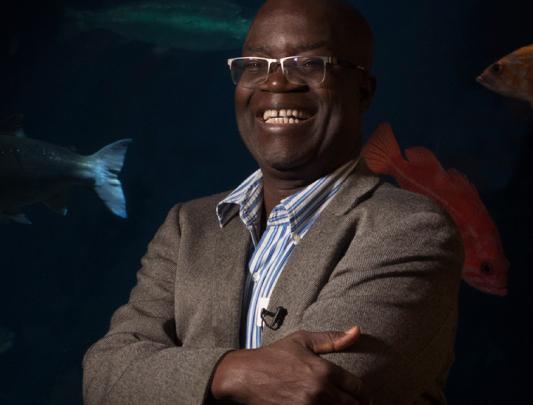Creating friendlier habitats for birds and bees
THE BIRDS...
A thump, a small stunned body, perhaps a grisly smear on the window‑pane: most of us have seen or heard a bird crashing into glass, but it’s hardly an everyday experience, and we might be forgiven for assuming that such avian accidents are isolated cases of bad luck.
Bird collisions, however, are much more common than most of us realize. In fact, buildings are glassy death traps, knocking out birds in droves. UBC student researchers who undertook the macabre task of counting telltale bodies, feathers, and smears found that as many as 10,000 birds a year die from colliding with buildings on the Point Grey campus alone.
The campus shares skies and trees with a particularly robust population of birds. This is due to its location near the Fraser River Estuary, where birds from three continents cross paths as they make their way along the Pacific Flyway, a vast migratory route from Alaska to Patagonia that’s travelled by at least a billion birds.
That we need these creatures may be obvious: pollinating plants and transporting seeds, birds are essential to ecosystems – and, besides, they are lovely. What would poetry be without birds? No “thing with feathers,” (Emily Dickinson), no whistling blackbird’s inflection and innuendo (Wallace Stevens), no darkling thrush “to fling his soul / Upon the growing gloom” (Thomas Hardy). Less obvious may be how, exactly, we can stop the thing with feathers, the blackbird, and the thrush from smacking into our windows.
UBC students, staff, and faculty from SEEDS (Social Ecological Economic Development Studies) Sustainability program have collaborated on an innovative answer. They’ve used campus as a living lab to create official design guidelines, part of UBC’s Green Building Action Plan, to make our buildings less of a bird‑bashing menace.
The Bird Friendly Building Design Guidelines draw on what scientists know about birds’ visual perception. Birds see glass as thin air, or they mistake reflections for real, inviting landscapes. This means that windows in bird‑friendly designs should be screened, glazed, or patterned to make the glass perceptible (window markings must have spaces no larger than two inches by four inches, otherwise birds will think they can squeeze “through” the gaps). The guidelines also recommend strategies such as installing motion‑sensitive light fixtures, or simply drawing shades, to minimize the light pollution that disorients migrating birds at night.
These details might seem burdensome at first glance, but the array of bird‑friendly solutions in various UBC buildings attests that designing with biodiversity in mind also encourages a diversity of creative problem‑solving. For instance, the Bookstore’s designers created visual markers for birds by asking the UBC community to submit their favourite literary quotes, and then etching those words in small white text across the windows. At the Beaty Biodiversity Research Centre, some windows are tucked behind exterior mesh screens, which let in plenty of light but appear solid to birds. On other panes, volunteers have doodled cheerful patterns with oil‑based markers.
The Centre for Interactive Research on Sustainability (CIRS) tucks windows behind a “living wall” of vine‑covered mesh. The plants lose their leaves in winter, letting in more light during rainy months and providing more shade during summer. In 2017, SEEDS hosted a campus‑wide contest to design bird‑friendly decals for other CIRS windows. The winning creation, by PhD student Lora Zosia Moon, featured intricately‑patterned depictions of campus flora and fauna, protecting birds while educating the public about wildlife at UBC.
All these design innovations are not costly, nor are their benefits just for the birds: window screens naturally regulate buildings’ temperatures, and window art gives spaces a quirky and personal touch. With this in mind, all new buildings at UBC will comply with the bird‑friendly guidelines by 2020, part of the university’s goal for campus buildings to make net‑positive contributions to biodiversity by 2035. That’s a lofty hope, perhaps, but one that’s both possible and necessary.
Surely, the poets would agree. “Thou wast not born for death, immortal Bird!” cries Keats in “Ode to a Nightingale.” Granted, there might not be any nightingales at UBC – but thanks to some creative design, their comrades will warble on, “sing[ing] of summer in full-throated ease.”
... and THE BEES
How many species of bees can you name? Honeybees, bumblebees... That’s about as far as most of us get – but honeybees, though much discussed these days, are far from the only pollinators we rely on, nor are they native to Canada. In fact, there are more than 800 bee species in Canada, and about 20,000 in the world.
Dr. Nancy Holmes, a poet and creative writing professor at UBC Okanagan, wants us to look more closely at the pollinators buzzing around us. She began learning about bee diversity four years ago, and was astonished by the many species in her own garden: a rainbow of bees – iridescent blue, green, purple, jet-black – ranging in size from several inches to as miniscule as a grain of rice. “Suddenly I see things I’ve been blind to all my life,” she says. “It’s been a beautiful revelation in my own backyard.”
Holmes’ revelation was threefold: First, wild bees are seriously cute. Second, they’re essential to ecosystems – one mason bee, for instance, pollinates 400 times more efficiently than a honeybee. Third, wild pollinators are in grave danger, threatened by a trifecta of disease, exposure to pesticides, and loss of habitat.
Part of the problem, according to Holmes, is that most of us aren’t even aware that wild bees exist. Without a place in our imaginations, we “erase them from our possible caring and stewardship.”
To change that, Holmes teamed up with Dr. Cameron Cartiere, an artist and professor at Emily Carr. If it strikes you as odd that a poet and an artist are insect advocates, consider: who better than two creative communicators to bedazzle dusty research into compelling community action? The duo founded Border Free Bees, a public art initiative that partners with scientists to raise awareness about wild pollinators, and empowers “citizen-scientists” to create bee habitats.
Since the monotony of lawns and shrubs in urban areas has starved pollinators of the diverse plants they need, Border Free Bees transforms underused city land, such as BC Hydro rights-of-way, into vibrant meadows. In 2015, they created their first “pollinator pasture” at the Bridgeport Industrial Park, inviting 600 elementary-school students to cultivate and plant sunflowers on the plot; other children harvested mustard seeds from the meadow, and volunteers crafted “insect hotels” to encourage native bees to take up residence there. The following year, to encourage conversations about the plight of pollinators, the group planted flowers in the shape of huge bumblebee wings, visible from the airport flight path overhead.
While the Richmond pasture is carefully cultivated, the initiative also “re-wilds” other plots of underutilized land, rescuing hearty weeds from development sites and transplanting them onto their pollinator havens. (The weeds might not look like much, Holmes says, but they suit the bees just fine.)
Whether partnering with developers-turned-weed-donors or with sunflower-planting schoolchildren, community involvement is central to the initiative’s ethos. Perhaps no project better exemplifies this than the Kelowna Nectar Trail, for which 101 families, businesses, churches, and schools each committed to planting and caring for a small garden. The community created more than seven kilometres of “flowery stepping stones” for pollinators to travel safely through the city.
Inevitably, Holmes has become known as the local “Bee Lady.” Strangers phone the poet asking how to manage swarms and hives. “I don’t know what to do about that!” she laughs. “I’m not a beekeeper!” Maybe not, but Border Free Bees is irrefutable proof that poets, scientists, and schoolchildren all have a role to play in conservation. With many stewards, the trail of flowers grows, and the bees buzz on.
Wild Bees
Rhona McAdam
We, we multitude
sun-blossomed on leaves or
dark-spotting petal
pistil stamen. Knowing each
flower’s golden mean.
Sweet comfort there
for our young.
Priming our baskets
with pollen.
A day’s work
and a day’s work and a day and a day
more. All this purpose
purpose purpose.
The weeds the woods
the garden.
Those single single
destinations, never mix this
with that:
one source in its
many places.
We fly, we crawl, we gather.
And again.
Our futures waiting to be lardered.
So many homes
we have, our
dark places, combed and tunnelled,
crumbed with our comings and goings.
The neatness of our labours:
eggs entombed
with food
for an afterlife
we will not witness.
Our one season this
duty, duty.
(One of ten winning entries for a poetry competition run by Border Free Bees and co‑judged by UBC Okanagan’s Nancy Holmes)
























